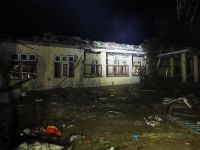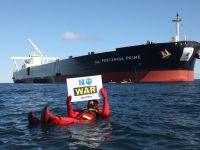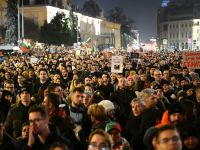Kuwait contains 96.5 billion barrels of proven oil reserves (including its share of the Neutral Zone), or roughly 9 percent of the world's total oil reserves. Along with Saudi Arabia and the United Arab Emirates, Kuwait remains one of the few oil producing countries with significant excess oil production capacity.
Note: Information contained in this report is the best available as of August 2000 and can change.
Refining :
Kuwait's refining capacity was damaged severely during Iraqi invasion and occupation in 1990-91. After losing most of its pre-war capacity of 820,000 bbl/d, Kuwait had only 200,000 bbl/d of refinery output by early 1992. Kuwait's $400-million downstream reconstruction program was completed in mid-1994.
As of last year, Kuwait's domestic refineries had a combined capacity of around 864,500 bbl/d. Mina al-Ahmadi is the country's largest refinery with capacity of 427,500 bbl/d. Other large refineries include Mina Abdullah (247,000 bbl/d) and Shuaiba (190,000 bbl/d). The bulk of Kuwait's refined products are exported.
On June 25, 2000, the Mina al-Ahmadi refinery experienced an explosion and fire, which caused substantial damage.
The facility had to be completely shut down. Kuwaiti authorities have put the cost of the damage at an estimated $330 million and have said repairs will take at least six months.
Foreign Downstream Operations :
KPC is expanding its overseas downstream interests in the hopes of attaining a combined European and Asian refining capacity of 700,000 bbl/d in the next few years. KPC recently pulled out of a $2 billion refining project in the Indian state of Orissa, but is reported to be considering acquiring a stake in India's Bangalore Refinery.
Kuwait Oil Thailand and Thai Petrochemical Industry are planning to build a 300,000-bbl/d refinery in Rayong, Thailand. KPC currently has 250,000 bbl/d of refining capacity in Europe, including half of Agip's 300,000 bbl/d Milazzo refinery. KPC also owns an 75,500 bbl/d unit in Rotterdam. These two refineries enable KPC to supply a large share of its 320,000 bbl/d in European outlets directly.
In September 1998, KPC announced the purchase of 157 service stations in Belgium from BP. The move gives KPC an 8% of the retail market share in Belgium. KPC's subsidiary, Kuwait Petroleum International, operates more than 5,000 service stations under the "Q8" banner in 10 countries in Western Europe and about 200 sites in Thailand.
Petrochemicals:
Kuwaiti officials have expressed interest in accelerating development of the country's relatively small petrochemical industry. This would accomplish several goals: boosting the value of Kuwait's crude oil reserves; helping to protect Kuwait's revenues during periods of low crude prices; and boosting Kuwaiti revenues while adhering to OPEC crude oil quota limitations.
Historically, Kuwait's Petrochemical Industries Company (PIC) has mainly manufactured low-value products such as urea, ammonia, and fertilizer for export. PIC is now beginning to move upmarket to production of higher-value products.
According to the Kuwait News Agency, PIC may increase production at its polypropylene plant by 20 percent to 120,000 tons per year if the market price of polypropylene continues to rise. PIC's primary markets are Jordan, Syria, the United Arab Emirates, Morocco, China and Hong Kong, followed by India, Pakistan and countries in eastern Africa.
The EQUATE joint venture, involving PIC and Union Carbide, is the country's largest petrochemical project. The $2 billion industrial complex at Shuaiba includes a 650,000 metric-ton-per-year ethylene cracker, two polyethylene units with a capacity of 450,000 metric tons per year, and a 350,000 metric-ton-per-year ethylene glycol plant, all of which are currently operating. The complex primarily serves the Asian and European markets.
PIC and Union Carbide each have a 45 percent share in the project, with the remainder owned by Boubyan Petrochemical Company. The EQUATE plant was temporarily shut down by the loss of its ethane feedstock from the Mina al-Ahamdi refinery in June 2000, but has since resumed operation.
NATURAL GAS Kuwait currently produces only a modest quantity of natural gas. Production stood at 330 billion cubic feet (Bcf) in 1998 - most of it associated gas from oil production. Kuwait plans to make a significant increase in its use of natural gas, especially in electricity generation. A switch to gas would free up a substantial amount of oil for export.
Kuwait and Qatar signed a memorandum of understanding (MOU) in July 2000 for export of Qatari gas from its offshore North Field to Kuwait. ExxonMobil, the operator of the North Field, is conducting a feasibility study. The volume of Qatari gas exports contemplated in the MOU have not been disclosed. Kuwait also signed an MOU with Iran for the import of gas via pipeline in July 2000. It is unclear whether the two gas import projects could both go forward.
Kuwait also hopes to improve its domestic gas production, both through a reduction of flaring of associated gas in oilfields and through new drilling. Exploratory drilling is currently being undertaken at the Rawdatain oilfield, reaching geological formations much deeper than the oil deposits, which are believed to be gas-rich.
In another gas-related development, Saudi Arabia and Kuwait concluded an agreement in July 2000 on the offshore Dorra gas field, which had been claimed by Saudi Arabia, Kuwait, and Iran. The agreement calls for an equal sharing of the gas resources between Saudi Arabia and Kuwait. Negotiations with Iran over its claims to the Dorra gas field are continuing.
ELECTRICITY:
As of 1998, Kuwait had an electrical generation capacity of 7 gigawatts (GW). Kuwait's electricity demand has been growing at around 5 percent in recent years, necessitating construction of new generating capacity. A 2,400-megawatt (MW) thermal plant at al-Subiya came online in early 2000, which relieved pressure on the system in the short-term.
The Ministry of Electricity and Water (MEW) comissioned a study of future power requirements in early 2000 from the German firm Lahnmayer, which recommended construction of a modest-capacity gas-fired peaking plant to handle short-term demand growth. The al-Zour North (AZN) project, which envisions another 2,400 MW plant near the existing al-Zour power plant, has been repeatedly delayed due to financial considerations. It is still considered the long-term solution for Kuwait's power needs, however, and current plans call for it to come online by 2006-2007.
ECONOMIC OVERVIEW:
Currency: Kuwaiti Dinar (KD)
Market Exchange Rate (8/21/00): US$1 = 0.307 KD
Gross Domestic Product (GDP) (1999E): $25.7 billion (2000E): $27.2 billion
Real GDP Growth Rate (1999E): 2.1 percent (2000E): 5.5 percent
Inflation Rate (1999E): 1.6 percent (2000E): 1.9 percent
Current Account Balance (1999E): $2.5 billion (2000E): $4.7 billion
Major Trading Partners: United States, Japan, Europe
Merchandise Exports (2000E): $14.1 billion
Merchandise Imports (2000E): $9.3 billion
Merchandise Trade Balance (2000E): $4.8 billion
Major Export Products: Petroleum
Major Import Products: Industrial goods, consumer goods, machinery, transport equipment, food
Total External Debt (2000E): None
International Reserves (2000E): $5.2 billion
OIL AND GAS INDUSTRIES:
Organization: The Supreme Petroleum Council governs the nationalized oil industry, which is run by Kuwait Petroleum Corporation (KPC). KPC subsidiaries include: Kuwait Oil Company (KOC) - exploration and production of oil and gas; Kuwait National Petroleum Company (KNPC) - refining and shipping; Kuwait Petroleum International (KPI) - refining and product marketing; Petrochemical Industries Company (PIC) - production and marketing of chemical products; Kuwait Foreign Petroleum Exploration Company (KUFPEC) - foreign exploration; and Kuwait Oil Tanker Corporation (KOTC) - tanker operations
Major Refineries (capacity - bbl/d, 1999E): Mina Al-Ahmadi (427,500), Mina Abdullah (247,000), Shuaiba (190,000) Major Oil Fields (reserves - billion barrels): Greater Burgan, Magwa, and Ahmadi (70+), South Magwa (25+), Raudhatain (6), Sabriya (3.8), Abdaliya (2), Umm Gudair, Minagish (2), Rugei, Bahra; Neutral Zone: Wafra, South Fawaris, South Umm Gudair, Al-Hout, Khafji
Major Pipelines: Raudhatain-Ahmadi; Minagish-Ahmadi; Umm Gudair-Shuaiba; Wafra-Mina Abdullah; Burgan-Ahmadi
Major Oil Terminals: Mina Al-Ahmadi, Mina Abdullah, Shuaiba, Mina Saud
Foreign Oil Company Involvement: British Petroleum, Chevron, Royal Dutch/Shell, Texaco
SOURCE: UNITED STATES ENERGY INFORMATION ADMINISTRATION
© 2000 Mena Report (www.menareport.com)







